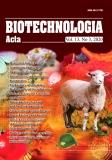ISSN 2410-7751 (Print)
ISSN 2410-776X (Online)

Biotechnologia Acta V. 13, No 3, 2020
Р. 73-80, Bibliography 17, English
Universal Decimal Classification: 579.861.2+57.017.22
https://doi.org/10.15407/biotech13.03.073
In vitro ACTIVITY OF THE ANTIBIOTIC BATUMIN AGAINST Candida albicans BIOFILM
L. N. Churkina 1, N. B. Perunova 2, О. V. Bukharin 2, Е. V. Ivanova 2, L. V. Yaroshenko 1
1 Zabolotny Institute of Microbiology and Virology of the National Academy of Sciences of Ukraine, Kyiv
2 Institute of Cellular and Intracellular Symbiosis, Ural Branch of Russian Academy of Sciences, Orenburg, Russian Federation
The aim of this work was to study action of batumin on the strains of Candida albicans and Candida krusei in planktonic and biofilm form and also to obtain more detailed insights into the influence of batumin on biofilm formation by using atomic-force microscopy. The Minimum Inhibitory Concentration (MIC) of batumin was studied according to CLSI standards. Formation of a biofilm was studied by the photometric O'Toole method by means of a plate photometer ELx808 (BioTek, USA) at wavelength of 630 nanometers.
The batumin has a high selective activity against staphylococci (MIC ≥ 0,25 μg/ml), at the same time, antibiotic, being not active concerning yeast of the genus Candida (MIC ≥ 512 μg/ml) showed the inhibiting action on biofilm formation of these microorganisms. Batumin influence on biofilm formation was studied in type, collection strains С. albicans, C. kruise and clinical isolates. Presence 0,125 µg/ml of batumin in the broth (1/2 MIC for staphylococci) reduced the biofilm formation at 55.6% of the studied strains. Their biofilm formation values varied for C. albicans from 1.5?3.9 CU (conventional unit: OD630 in experimental samples / OD630 in control samples), for C. krusei of 2.3?3.0. Batumin was more effective against Candida strains with strong biofilm formation.
Atomic force microscopy revealed qualitative changes in the exopolymeric matrix due to batumin treatment, as well as a significant reduction in the number of cells adhered to the coverslip, preventing formation of C. albicans 127 biofilm, However, C. albicans ATCC 24433 a significant reduction in the number of cells adhered to the coverslip weren't observed.
The data obtained by an Аtomic force microscopy confirm ability of a batumin to prevent formation of a biofilm at the studied strains that allows to consider it as the preventive agent at treatment of the infections caused by yeast-like fungi of the genus Candida.
Key words: batumin, Candida, biofilm, atomic force microscopy.
© Palladin Institute of Biochemistry of National Academy of Sciences of Ukraine, 2020
References
1. Sardi J. C. O., Scorzoni L., Bernardi T., Fusco-Almeida A. M., Mendes Giannini M. J. S. Candida species: current epidemiology, pathogenicity, bio?lm formation, natural antifungal products and new therapeutic options. J. Med. Microbiol. 2013, V. 62, P. 10–24. https://doi.org/10.1099/jmm.0.045054-0
2. Fanning S., Mitchell A. P. Fungal bio?lms. PLoS Pathog. 2012, V. 8, P. e1002585. https://doi.org/10.1371/journal.ppat.1002585
3. Ku T. S. N., Palanisamy S. K., Lee S. A. Susceptibility of Candida albicans bio?lms to azithromycin, tigecycline and vancomycin and the interaction between tigecycline and antifungals. Int. J. Antimicrob. Agents. 2010, V. 36, P. 441–446. https://doi.org/10.1016/j.ijantimicag.2010.06.034
4. Vogel M., K?berlel M., Sc?f?er H., Treiber M., Autenrieth I. B., Schumacher U. K. Rifampicin induced virulence determinants increase. Candida albicans bio?lm formation. F1000Research. 2013, V. 2, P. 106. https://doi.org/10.12688/f1000research.2-106.v1
5. Kiprianova E. A., Klochko V. V., Zelena L. B., Churkina L. N., Avdeeva L. V. Pseudomonas batumici sp.nov., the antibiotic-producing bacteria isolated from soil of the Caucasus Black Sea coast. Microbiol. J. 2011, V. 73, P. 3?8 (In Ukrainian).
6. Klochko V. V., Kiprianova E. A., Churkina L. N., Avdeeva L. V. Antimicrobial spectrum of antibiotic batumin. Microbiol. J. 2008, V. 70, P. 41?46 (In Ukrainian).
7. Bukharin O. V., Churkina L. N., Perunova N. B., Ivanova E. V., Novikova I. V., Avdeeva L. V., Yaroshenko L. V. Influence of antistaphylococcal antibiotic batumin on microorganisms biofilm formation. Zh. Mikrobiol. Epidemiol. Immunobiol. 2012, V. 2, P. 8?12. (In Russian).
8. Performance Standards for Antimicrobial Susceptibility Testing; Fifteenths Informational Supplement. CLSI/ NCCLS Document M100-S. Clinical and Laboratory Standards NCCLS. 2005, 165 p.
9. O’Toole G., Kaplan H., Kolter R. Bio?lm formation as microbial development. Ann. Rev. Microbiol. 2000, N 54, P. 49–79. https://doi.org/10.1146/annurev.micro.54.1.49
10. Megan E. N., Martin M. O., Chan P. H. Atomic force microscopy of bacterial communities, Methods Enzymology. 2005, V. 397, P. 256?258. https://doi.org/10.1016/S0076-6879(05)97015-8
11. Eaton P., Fernandes J. C., Pereira E., Pintado M. E., Xavier Malcata F. Atomic force microscopy study of the antibacterial effects of chitosans on Escherichia coli and Staphylococcus aureus. Ultramicroscopy. 2008, V. 108, P. 1128?1134.https://doi.org/10.1016/j.ultramic.2008.04.015
12. Lakin G. F. Biometry. Higher school. 1990, P. 352.
13. Ivanova Y. V., Churkina L. N., Avdeeva L. V., Perunova N. B. Effect of anti-staphylococcal antibiotic batumin on stages of biofilm formation in Candida albicans. Abstract of the materials of the 3rd Congress of Mycologists of Russia. Modern Micology in Russia, Moscow, Russia. 10?12 October 2013.
14. Churkina L., Vaneechoutte M., Kiprianova E., Perunova N., Avdeeva L., Bukharin O. Batumin ? a selective inhibitor of staphylococci ? reduces biofilm formation in methicillin resistant Staphylococcus aureus. Open J. Med. Microbiol. 2015, N 5, P. 193?201. https://doi.org/10.4236/ojmm.2015.54024
15. Bukharin O. V., Churkina L. N., Perunova N. B., Ivanova Y. V., Vasilchenko A. S., Avdeeva L. V., Yaroshekno L. V. Morpho-functional changes in biofilms of Staphylococcus aureus under the effect of batumin. Zh. Mikrobio.l Epidemiol. Immunobiol. 2013, V. 5, P. 3?8.
16. Gibson J., Sood A., Hogan D. Pseudomonas aeruginosa ? Candida albicans interactions: localization and fungal toxicity of a phenazine derivative A. and E. Microbiology. 2009, 75 (2), 504?513. https://doi.org/10.1128/AEM.01037-08
17. Sidrima J. J. C., Teixeira C. E. C., Cordeiro R. A., Brilhante R. S. N., Castelo-Branco D. S. C. M., Bandeira S., Alencar L. P., Oliveira J. S., Monteiro A. J., Moreira J. L. B., Bandeira T. J. P. G., Rocha M. F. G. ?-Lactam antibiotics and vancomycin inhibit the growth of planktonic and bio?lm Candida spp.: An additional bene?t of antibiotic-lock therapy. Int. J. Antimicrob. Agents. 2015, V. 45, P. 420–423. https://doi.org/10.1016/j.ijantimicag.2014.12.012

